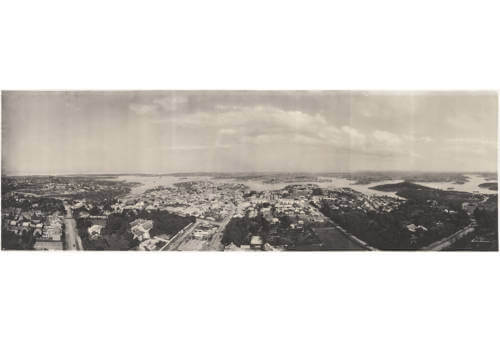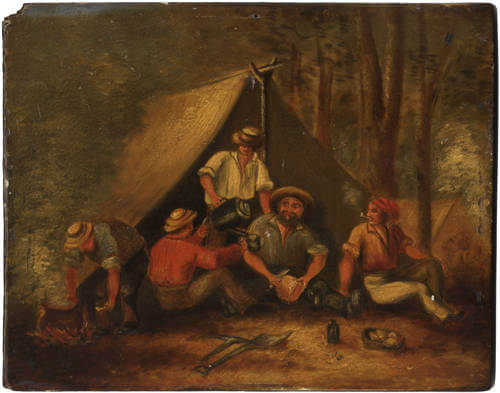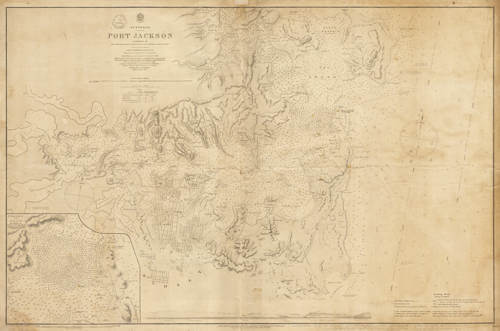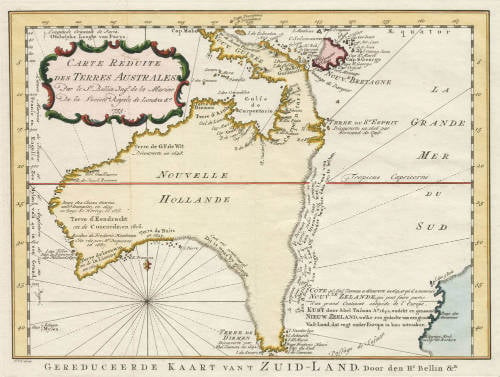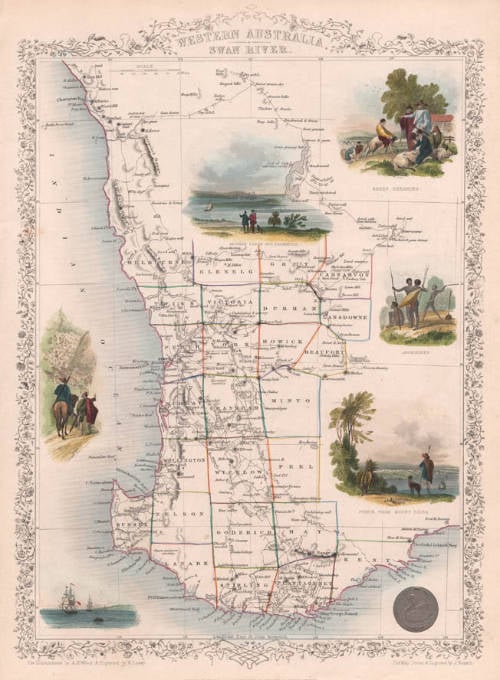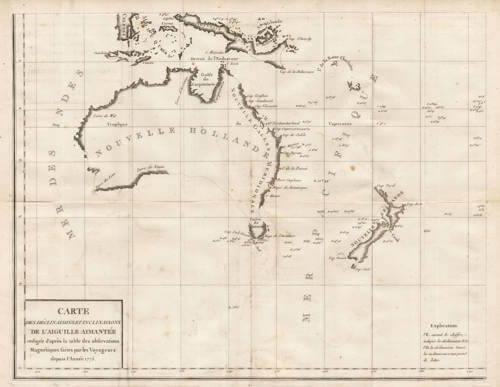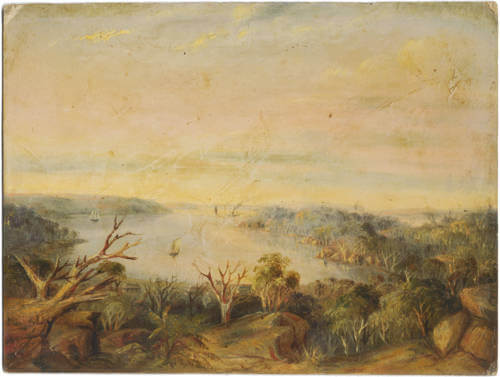Leen Helmink Antique Maps
The first aerial photo of Australia by Melvin Vaniman
Stock number: 19491
Zoom ImageCartographer(s)
Chester Melvin Vaniman (biography)
Title
[ Sydney Harbour ]
First Published
Sydney, 1904
Size
37.6 x 117.8 cms
Technique
Condition
pristine
Price
$ 3,250.00
(Convert price to other currencies)
Description
The rare first aerial photograph of Australia
Sunday March 27th, 1904.
Large vintage platinum photograph, panorama, annotated “registered” and signed in the photo negative lower right.
This is believed to be the first aerial photograph taken in Australia. It seems to be the only documented panorama of Sydney taken by Vaniman from a specially-designed hot air balloon he imported from America. The balloon was stationed over Bay Road, North Sydney (now Waverton), most likely on the 27th of March 1904; the photograph had to be taken on a Sunday to avoid smoke from factories. It shows Sydney Harbour from North Head to beyond Iron Cove Bridge. The image is a contact print produced from a single large-format negative from a circuit camera Vaniman constructed himself.
Vaniman had intended that his panoramas be exhibited in public buildings as massive enlargements, but today they survive as extremely detailed platinum contact prints.
(Josef Lebovic Gallery)
Vaniman Panorama
His panoramic photographs were nearly always taken from high above the ground and if a nearby building or ship’s mast was not at hand, he erected his own 30-metre pole to achieve a bird’s-eye view. When his trusty pole didn’t give him the height necessary to photograph the entire city of Sydney in a single sweep, he imported a balloon from America and spent months tethered 180 metres above North Sydney, experimenting with the new perspective. Vaniman even built his own camera, able to record panoramic views on film up to two metres in length and 50 cm wide in a single shot.
The viewing public in the early 1900s greatly enjoyed panoramic exhibitions, and Vaniman had always intended that his panoramas be seen as massive enlargements up to five metres long. Most of Vaniman’s panoramas survive as platinum prints, contact printed from the original negatives. These prints were expensive to produce and required exposures of between two and four hours in sunlight, but their longevity and exquisite tonality have made Vaniman’s persistence with the technique worthwhile.
Chester Melvin Vaniman was born to a farming family in Illinois in 1866, the eldest of four sons. His formative years on the farm gave him a lifelong interest in agriculture and experience with all sorts of machinery. He went on to study music at Valparaiso University in Indiana and later in Chicago. He became a music teacher in Iowa, before joining a touring opera company in Louisiana in 1887 and singing his way through almost every state of America. It was during his 11-year singing career that Vaniman developed an interest in photography, recording the towns he visited. Around 1900, he married hometown sweetheart Ida Loud in Honolulu and spent two years as an electrician, before trying photography as a profession in Hawaii in 1901.
Vaniman’s unusual panoramas caught the eye of the Oceanic Steamship Company, which commissioned him to photograph places visited by their vessels in New Zealand and Australia, as an incentive for tourists. Vaniman arrived in Auckland in 1902 and spent a year photographing both islands, not only for the company, but also for the New Zealand Government, who wanted his spectacular images to encourage tourism. The New Zealand Free Lance described his panorama of Auckland as ‘a poem that will run into several editions, and take a good deal of wall space to give it effective exhibition’ (New Zealand Free Lance 21 March 1903).
Vaniman reached Sydney in February 1903. His itinerary is not fully known, but he clearly spent a year, on and off, photographing Sydney. He described it as his favourite place in Australia: ‘... my chief love in this country is Sydney. I am very fond of it; its residents and — of its climate’ (New South Wales Railway Budget 2 May 1904).
Journeys were made to Melbourne in November 1903 for the Melbourne Cup, the Blue Mountains later in the month and to the central west of New South Wales in December to photograph the record wheat harvest, which impressed the agriculturalist in Vaniman greatly. He travelled the New South Wales coast between Nowra and Newcastle, with excursions as far afield as Cairns and Rockhampton in Queensland; and Hobart, Launceston and Queenstown in Tasmania.
Without doubt, the most technically interesting of his Australian photographs was the panorama of Sydney taken from a balloon in March 1904. Photographs from balloons had been taken in the mid-nineteenth century, but they were mostly poor quality. Vaniman always believed his to be the first attempt to record a city landscape. Celebrated American aerial photography pioneer George Lawrence used a balloon in 1901 and certainly recorded San Francisco from an array of kites with a panoramic camera in 1906, but Vaniman’s 1904 image of Sydney seems to predate Lawrence’s best known achievements. Determining soon after his arrival in Sydney that an elevated viewpoint was necessary to show the harbour city to best advantage, Vaniman ordered a balloon from America. It arrived at the end of June 1903 and tests began almost immediately, although the first successful ascent using town gas was not recorded until October of that year. Vaniman thought his cameras were not good enough for the task and built a new rotating camera, which he described as a special ‘box of tricks’ (Sydney Mail 27 April 1904) to counter the swaying of the balloon and the difficulty of the distant subject. After expending nearly £200 and nine months experimenting with the balloon and camera, Vaniman took his celebrated image on or about 27 March 1904.
After leaving Sydney in May 1904, Vaniman took panoramas in South Australia and Western Australia, before leaving for Europe the following August. He had intended to continue his balloon photography of major cities and travelled through Austria, Germany and France, but apparently was less successful there because of poor atmospheric conditions.
Vaniman knew that Australia’s clear light was a bonus to photographers and had even commented on it in an interview just before he left Sydney: ‘You have a splendid light … and beautiful clouds: no question about that. Especially up country the atmosphere is beautifully clear, and in Bathurst I got one of the most beautiful skies I have ever met’ (New South Wales Railway Budget 2 May 1904).
(Lisa Loader, SLNSW Vaniman Exhibition June 2009-January 2010)
Literature
Alan Tierney, Melvin Vaniman: A biographical note, Goulburn 2000, pp.18-22.
Lisa Loader, Vaniman Panorama exhibition catalogue, 2010, SLNSW.
Rarity
The photo is exceptionally rare.
Significance
This is believed to be the first aerial photograph taken in Australia. It seems to be the only documented panorama of Sydney taken by Vaniman from a specially-designed hot air balloon. The balloon was stationed over Bay Road, North Sydney (now Waverton), most likely on the 27th of March 1904; the photograph had to be taken on a Sunday to avoid smoke from factories.
Condition description
Unusually fine collector's condition.
Chester Melvin Vaniman (1866–1912)
Chester Melvin Vaniman (October 30, 1866 – July 2, 1912) was an American aviator and photographer who specialized in panoramic images. He shot images from gas balloons, ships masts, tall buildings and even a home-made 30-metre (98 ft) pole. He scaled buildings, hung from self-made slings, and scaled dangerous heights to capture his unique images.
Born to a farming family in Virden, Illinois, Vaniman was the eldest of four sons and attended Valparaiso University in Indiana and Chicago.
Vaniman's photographic career began in Hawaii in 1901, and ended some time in 1904. He spent over a year photographing Australia and New Zealand on behalf of the Oceanic Steamship Company, creating promotional images for the company, many as panoramas and which popularised the format in Australia, which was taken up with enthusiasm by Robert Vere Scott among others. During this time the New Zealand Government also commissioned panoramas.
Beginning in 1903, he spent over a year photographing Sydney and the surrounding areas. It was during this time that he created his best known work, the panorama of Sydney, shot from a hot air balloon he had specially imported from the United States. Vaniman is best known for his images of Hawaii, Australia, and New Zealand.
Some time around 1904, he gave up photography and took up exploration. This included attempts at the North Pole and the Trans-Atlantic crossing, both of which were attempted in Walter Wellman's airship America.
At the first attempt to cross the Atlantic in 1910, Vaniman sent one of the first aerial radio transmissions when he urged the launch boat to "come and get this goddamn cat!" The cat, named Kiddo, had caused such a ruckus that it finally had to be placed inside a gunny sack and suspended below the airship's gondola.
They anticipated a five-day crossing, but the airship's motor failed after 38 hours, leaving it adrift until the crew (and Kiddo) was rescued two days later by the SS Trent, a passing Royal Mail steamship. The America drifted away and was never seen again.
Vaniman died during his second attempt at a trans-Atlantic airship crossing when his airship, the Goodyear built Akron, (not the later US Navy airship of the same name) exploded off the New Jersey shore on July 2, 1912. Filled with 11,300 cubic meters of hydrogen gas, his was the first American airship that could compare to the better known European manufactured models.
Vaniman and his crew of four were killed just a few minutes after the Akron departed on its trans-Atlantic flight, when the airship suddenly exploded offshore in view of the gathered crowd near Atlantic City, and the burning gondola plunged from the sky into an inlet. The other victims were his brother, Calvin Vaniman, Fred Elmer, George Bourtillion, and Walter Guest. Subsequent investigation indicated that internal pressure possibly from overinflation of hydrogen had ruptured the envelope.
(Wikipedia)
Related Categories
Related Items
